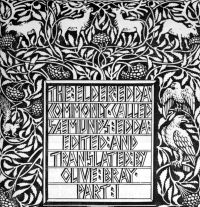
|
|
Viking & Germanic People
|



|
|
Aquila
In Norse mythology,
Veđrfölnir, meaning "storm pale" or "wind bleached" is a hawk sitting between
the eyes of an unnamed eagle that is perched on top of the world tree Yggdrasil.
|
 Veđrfölnir
VeđrfölnirBjorn Jónsson's Viking starmap Source: germanicmythology.com |



|
|
Boötes
In his interpretation of the Völundarkviða, a mythological poems of the
Poetic Edda,
Peter Krüger identifies the constellation Boötes as
Níðuðr (or Niðhad), a cruel king in Germanic legend.
|



|
|
Canis Major
In Norse mythology, Sirius
is called Lokabrenna, literally meaning "burning done by Loki". Commonly, it is referred to as "Loki's torch."
|
 Loki in a 16th-century
Loki in a 16th-centuryIcelandic manuscript Source: norse-mythology.org |



|
|
Cepheus,
Lyra and
Perseus
In Norse mythology,
Dáinn, Dvalinn, Duneyrr and Duraţrór are
four stags that eat among the branches of the World Tree Yggdrasill.
|
 The four stags in
The four stags inthe Tree of Yggdrasill Sæmund's Edda, 1908 Source: Wikipedia |



|
|
Gemini
The formation Auguthjaza (Eyes of Þjazi) is the only formation
of stars mentioned in the Edda.
|

|

The Hárbarðsljóð is one of the poems in the
Poetic Edda, describing a verbal contest between Thor
and Odin who appeared as the ferryman
Hárbarðr (Greybeard).
 According to this poem, it was not Odin but Thor who claimed to have made Þjazi's eyes into stars:  In the poem, Thor said:  I killed Þjazi, the powerful minded giant. I killed Þjazi, the powerful minded giant. I threw up the eyes of Olvaldi's son I threw up the eyes of Olvaldi's son into the bright heavens. into the bright heavens.
 Source: Wikipedia |
 Thor by W. G. Collingwood
Thor by W. G. Collingwood |
 Hárbarðr by W. G. Collingwood
Hárbarðr by W. G. Collingwood
|



|
|
Lyra
According to Jonas Persson, Vega
was called Sudrstjarna, the "South Star", as it is visible in the southern sky during summer and in the south at midnight during summer
solstice.
|



|
|
Milky Way
Bifröst, a burning rainbow bridge that reaches between
Midgard (Earth) and Asgard (the realm of the gods)
is described in 13th century Norse mythology in both the
Poetic Edda and the Prose Edda.
|
 Thor and the æsir crossing Bifröst
Thor and the æsir crossing BifröstLorenz Frølich, 1895; Wikipedia |



|
|
Orion
In at least one study, Orwandil is identified as the Norse name of Orion with Rigel being one of Orwandil's toes. This refers to
Aurvandil the Valiant a figure from 13th century's
Younger Edda.
|

|



|
|
Orion and Scorpius
There may be some analogies between the Greek legend of Orion and the Scorpion in Germanic mythology, where a mystic sword takes the place of
the scorpion's stinger. In the Ţiđreks saga King
Niđung orders two smiths, Wayland
(also known as Velent or Volund and Amilias, to forge an armor, a helmet and a sword, to determine,
which of them is the better smith. Amilias forged a helmet and suit of armor while Wayland forged a sword, named
Mimung. When the king puts both to the test, the sword easily cuts through the
helmet and the suit of armor, killing Amilias.
|

|



|
|
Pleiades
The Vikings called the Pleiades
Freyja's hens.
The star cluster of the Pleiades is part of the constellation Taurus, but given the amount of Star Lore related to them, they deserve a separate entry. |



|
|
Scorpius
Richard Denning identified Scorpius as
Níðhöggr.
Sources:
Richard Denning: What did the Vikings and Saxons call the Stars?, |
 Níðhöggr gnaws the roots of Yggdrasill
Níðhöggr gnaws the roots of Yggdrasill17th-century Icelandic manuscript. Sources: Wikipedia, Mathisen Corollary
|

In Star Myths of the Vikings, Bjorn Jónsson suggests, that the
southern part of Scorpius represents Hvergelmir, a spring mentioned in both the
Poetic Edda and Prose Edda.
 The spring is located in Niflheim the realm of primordial ice and cold. It is the origin of all the cold water in the world. The spring is fed by dew dripping from his horns of a stag named Eikthyrinr. into the well.  In spite of being the source of could water, Hvergelmir is also the home of countless snakes.  Sources: Bjorn Jónsson, Blog Mythology and Cultures. |
 Hvergelmir
HvergelmirBjorn Jónsson's Viking starmap Source: germanicmythology.com |



|
|
Taurus
The Hyades are a star cluster that is part of the constellation Taurus.
|
 Ulf's Keptr; Norse Constellations
Ulf's Keptr; Norse Constellations
|



|
|
Ursa Major
In Norse mythology, the Big Dipper was seen as a wagon driven by a god.
|
 Karlsvagn;
Jonas Persson
Karlsvagn;
Jonas Persson
|
The Nordic version of the wagon has survived into modern times. In German, the Big Dipper is still called Grosser Wagen (Great Wagon). In Scandinavia, it is
called Karlavagnen (Swedish), Karlsvognen (Norwegian) or Karlsvognen (Danish), all meaning Charle's Wagon, derived from the
Anglo-Saxon word Churl for man.
 Sources: Wikipedia, Jonas Persson: Norse Constellations, Richard Denning: What did Vikings and Saxons call the stars |



|
|
Ursa Minor
According to Jonas Persson, the Big Dipper and
Ursa Minor are called the Karlsvagn (Man’s Chariot) and Kvennavagn
(Woman’s Chariot), respectively, suggesting that the man is Thor, while the woman in the smaller wagon
is Freyja.
|

|



|
|
Virgo
In his interpretation of the Völundarkviða, a mythological poems of the
Poetic Edda,
Peter Krüger identifies the constellation Virgo as
Böðvildr (or Bodhild), daughter of king
Niðhad (who, in Krüger's theory is represented by
Boötes).
|
 Böðvildr, handing the broken ring to Weyland
Böðvildr, handing the broken ring to Weyland1901 illustration by Johannes Gehrts Source: religion.wikia.org |
| Source: Germanic Astronomy: The Kneeling man and the Virgin with the Golden Ring |


|
Back to Star Lore |
Back to Mythology |
Back to Space Page |
Back to English |
 Back to Start Page |